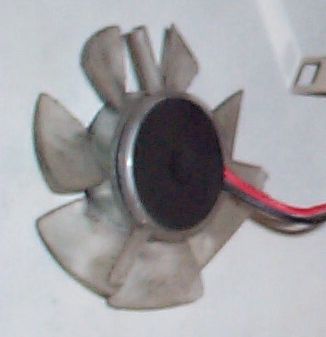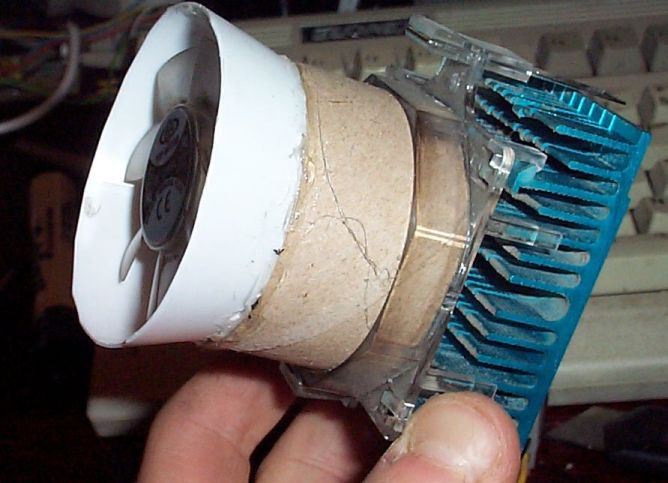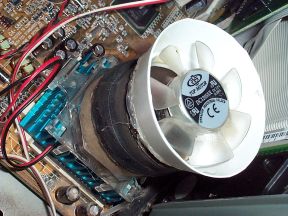 The first modification is simply to slow the thing down a bit. Insert
a resistor of some tens of ohms in a fan lead. Sometimes I use a diode
depending on what presents itself first from my component draw.
The first modification is simply to slow the thing down a bit. Insert
a resistor of some tens of ohms in a fan lead. Sometimes I use a diode
depending on what presents itself first from my component draw.
Some of the techniques documented herein can cause loss of data, damage to your computer, electrocution and possibly even electrical fire. The reader should be experienced in tinkering with things electronic before even thinking about opening up a power supply or modifying the CPU cooler. So there.
 The first modification is simply to slow the thing down a bit. Insert
a resistor of some tens of ohms in a fan lead. Sometimes I use a diode
depending on what presents itself first from my component draw.
The first modification is simply to slow the thing down a bit. Insert
a resistor of some tens of ohms in a fan lead. Sometimes I use a diode
depending on what presents itself first from my component draw.
The second is to change the mounting to reduce the vibration transmitted to the motherboard. There are nice cooling systems from the likes of Zalman (which I am not personally endorsing but am aware of) that seem to do this properly but here's the kind you can do yourself.
My main Pentium-class machine has the kind of cooler where the fan
cage cannot be seperated from the rest of the assembly because the
mounting clips go through it. Instead I cut the three spokes
supporting the motor at their outsides.
 I found that a could fit a top quality cardboard insert into the fan
cage and beyond that an equally expensive plastic funnel. Maybe I
should have tried harder to mount the fan in the cardboard section but
I didn't.
I found that a could fit a top quality cardboard insert into the fan
cage and beyond that an equally expensive plastic funnel. Maybe I
should have tried harder to mount the fan in the cardboard section but
I didn't.
 Here's the nealy finished article. Any resemblance to a bit of bog
roll glued to the top of a salt cellar is inevitable really.
Now I ran it up on the motherboard and though pleased with the result
felt I could do better. I got some special suspension quality rubber
(old inner tube) and inserted a ring of that between the cardboard and
plastic.
Here's the nealy finished article. Any resemblance to a bit of bog
roll glued to the top of a salt cellar is inevitable really.
Now I ran it up on the motherboard and though pleased with the result
felt I could do better. I got some special suspension quality rubber
(old inner tube) and inserted a ring of that between the cardboard and
plastic.
 Here it is running in place. Of interest (if, like me, you sometimes design
power supplies for a living) are the black and gold electrolytic
capacitors on the motherboard. They're an important part of the switch
mode supplies for generating the 1.8v, 2.5v or whatever your processor
needs. This machine is almost seven years old. A few days ago I was
looking at a maybe three year old and flaky machine and every one of
these capacitors had bulbous metal tops.
Here it is running in place. Of interest (if, like me, you sometimes design
power supplies for a living) are the black and gold electrolytic
capacitors on the motherboard. They're an important part of the switch
mode supplies for generating the 1.8v, 2.5v or whatever your processor
needs. This machine is almost seven years old. A few days ago I was
looking at a maybe three year old and flaky machine and every one of
these capacitors had bulbous metal tops.
To reduce the air whooshy noise from the back some people might suggest turning the fan round so it blows into the case. The problem is that in a tower where the PSU is mounted at the top it will cause a buildup of hot air. A possibly better arrangement is a bottom mounted PSU with an intake fan. Though it might make it painful though refreshing to sit down.
Apply this patch, based on what I found
on a mailing list somewhere to your FreeBSD 4.9 kernel source, build
and install taking the usual precaution of keeping the original
kernel around. Check the new kernel works. Then put this line in your
loader.conf adjusting the number of seconds to taste and reboot.
hw.ata.suspend=230
There's more to do to keep disk activity down to a minimum. Assuming you make no use of atimes change the mount options of the relevant filesystem(s) to noatime by editing the fstab (and remounting). That'll prevent atimes being written each time a file is opened, even for read.
cron likes to log the fact it woke up and did nothing every minute. Either remove /var/log/cron or adjust syslog.conf to stop it.
Look in /var/log for other too-frequently written log items and configure to reduce their frequency.
One more thing to note. Maybe the patch isn't immaculate as while booting my machine sometimes spins a disk down there and then, times out on ata0 something and generally gets a bit confused. But it always recovers within a few seconds with no harm done.